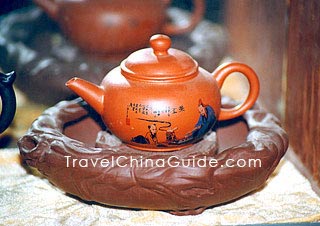Pottery may be the oldest artwork of human beings. As far back as the Neolithic Age (more than 8,000 years ago), people began mixing clay and water then baking it until it held its shape. Ancient people attached the word 'pottery' to their discovery and used it to create various vessels and tools to improve the quality of life. Over the course of thousands of years, they became dominant wares in people's daily life: used to cook, to store things, and to hold cuisine or waters as dishes.
As time passed, the technique became more and more consummate. Different kinds of pottery appeared in different times and regions. Yangshao Culture, 5,000 - 7,000 years ago to today, developed a technique for painted ceramic wares. Qujialing Culture and Longshan Culture, dating back about 4,000 years ago, were known for their black ceramic wares. During the Shang Dynasty (16th - 11th century BC) bronze vessels grew into somewhat of a status symbol; common people, though, still used traditional clay ceramic wares. Workshops of grey and white potters took the artistic features of bronze wares and decorated their articles ornately.
 | A basin with the pattern of
human face and fish, Neolithic Age | |  | Pottery Handcraft,
Ancient Kiln, Jingdezhen | |
From the Warring States Period through the Han Dynasty, the art and culture of pottery thrived. In addition to creating everyday pieces, ceramic beasts and warriors were created and buried with the grandees. The
Terra Cotta Warriors, discovered in Xi'an, are the finest representatives of artworks of that time. Visitors to the Warriors are continually amazed by the grandeur and elaborate displays of the well-preserved army. During the Three Kingdoms Period (220 - 280), the forging technique of porcelain gradually replaced traditional ceramic handiwork.
Another fine example of beautifully crafted pottery is the tricolor glazed pottery of the Tang Dynasty (618 - 907). The pieces were created by adding various metals oxide and baking at a low temperature. The glazed pottery would appear to be light yellow, reddish brown, shamrock or light green. The most popular were those of yellow, brown and green. The sculpting of figures, animals or daily appliances was amazingly in accord with the characteristics of Tang art - graceful and lively. Preferred by many foreigners to the region, the tricolor glazed pottery had been transported all over the world.
 | | Tri-color Glazed Pottery, Tang Dynasty | |  | | Purple Clay Teapot | |
Another choice pottery that won great reputation for hundreds of years is purple clay pottery. It is well-known for its mild color, condensed structure, high intensity and fine particles. As early as the Song Dynasty (960 - 1279), people found purple clay teapots to look much more graceful than those of other materials. In the Ming and Qing Dynasties, tea developed as a simple and tasteful art. People who liked drinking tea held firm to the belief that tea in the purple clay pot smelled balmier and could retain the original quality; these teapots transferred heat slower and were more endurable of heat; after long time's use, the teapot would not fade but become more lustrous. Modern people still delight in this classic fashion ideal.
- Last updated on Aug. 08, 2022 -



